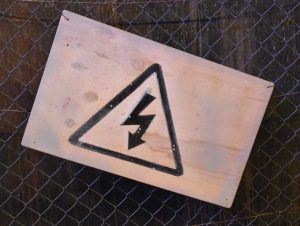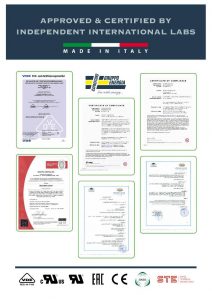When handling capacitors and other electrical components, it is fundamental to religiously follow some safety rules, in order to prevent any future problems.
Safety Rules to Follow
Power capacitors are electrical energy storage devices, thus you must always handle them with caution.
Even if they are turned off for a long period of time, capacitors might still be charged with high voltage, and this may be lethal. For this reason, please be extremely careful when handling capacitors and electrically connected devices.
You must always comply with the general rules of good electrical engineering practice when handling components in electrical systems.
In particular, before putting a new capacitor on duty, please make sure to check the following aspects a few times:
- capacitance;
- resistance of discharging devices;
- overall screws tightening at the specified torque (when applicable).

A good rule of thumb is to assume that a capacitor is always charged. Therefore, before touching or being anyhow in contact with its terminals, you should always discharge the capacitor by short circuiting its terminals to each other and to ground.
General Conditions for Storage and Use
- You should always store capacitors in a dry and safe place indoors, in an upright position (not upside down).
- You must never store capacitors on top of each other.
- Never store or use capacitors outside the specified temperature ranges. The ambient temperature category for most standard types is -45/60° C. This means a max. temperature of 55°C and an average temperature over 24 hours of 45°C. The average temperature in one year should not exceed 35°C. The maximum casing temperature should not exceed 6O°C. Temperature is one of the main stress factors for polypropylene type capacitors. It has a major influence on the lifespan of these products. Exceeding the maximum allowed temperature may set the safety device out of operation.
- Do not store or use capacitors in corrosive atmospheres, particularly when chlorides, sulfide, acids, alkalis, salts, organic solvents or similar substances are present.
- Perform a regular maintenance and cleaning, especially of the terminals, in order to avoid a conductive path between phases and/or phases and ground. This applies especially to dusty or dirty environments.
- You must never use in any way mechanically or electrically damaged, leaky or otherwise damaged capacitors.
- Never manipulate, remove or impair in their function existing protective devices on capacitors.
- Always check the integrity of discharge resistors before installation.
- In order to prevent malfunction, you must provide a means of sufficient dissipation of heat (fan, cooling) and escaping gases. Always make sure to maintain the required minimum distances (e.g. from sources of heat).
Risk Factors for Capacitors
The most frequent risk factors which cause capacitor damage and possible failure of the internal protective devices are:
- Exceeding the allowed temperature on the capacitor surface (a steady increase by 7°C of the operating temperature cuts the product lifespan by half).
- Overvoltage, overcurrent and high inrush currents, even if they only occur briefly or cyclically (a steady increase by 8% of the operating voltage of the capacitor, diminishes by half the product lifespan).
- Network harmonics, resonances created by harmonics or flickering even when they occur only briefly or cyclically.
- Aging of the lighting equipment, excess temperature or high UV stress.
- Failure of other components in a common circuit and overvoltage or overcurrent.
- Interaction with other reactive power components, and parasitic capacitances or inductivities (cable) in common circuits.
- Even if the test based on the capacitor standard is passed, this does not ensure comprehensive protection against all possible overloading.
- Power capacitors can be a significant risk in case of failure due to their stored energy and/or their properties during operation in networks with high short-circuit power.
- Capacitors can actively fail when internal or external protective devices are missing, they are incorrectly dimensioned or have failed. They can burst, burn or, in extreme cases, explode.
- Gases (e.g., hydrocarbons as decomposition products of the organic insulating materials used) released in case of damage are flammable and can create explosive mixtures. The fire load of a power capacitor is approx. 40 MJ/kg.
Please note that, depending on size, combustible materials make up around 55% of the total mass of small capacitors and around 75% of big capacitors.
Risk minimizing measures
The capacitor manufacturer cannot predict every possible stress which a power capacitor may be subjected to, and which has to be taken into account in a proper design. This means that the user bears crucial co-responsibility.
For this reason, safety and quality should be the main priorities when selecting a capacitor.
- Before designing the application, capacitors must be checked for their suitability for that specific application. You must carefully consider every parameter.
- Any unconsidered use for an application may have serious consequences.
- Always supplement internal protective devices of the capacitors with suitable external protective measures, in particular in case of sensitive applications.
- External protective measures are mandatory when capacitors are used without internal protective devices.
- When using capacitors, please take any suitable measure possible in order to eliminate possible danger to humans, animals and property, both during operation and when a failure occurs. This applies to all types of capacitors, both without and with protective devices.
Cautions and Warning
Never use capacitors that have dents of more than 1 mm depth or any other mechanical damage. This applies also in cases of leakage.
To ensure the functionality of the overpressure disconnector, do not hinder elastic elements. Furthermore, keep a minimum space of 12 mm above each capacitor. Finally, check the tightness of the connections/terminals periodically.
The energy stored in capacitors may be lethal. To prevent any chance of shock and short circuit, make sure to discharge the capacitor before handling.

